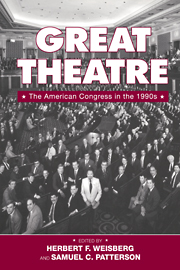Book contents
- Frontmatter
- Contents
- Figures and Tables
- Preface
- Contributors
- Introduction
- Congress and Its Audience
- Congress at Play
- Congress and Other Actors
- 8 The Plot Thickens: Congress and the President
- 9 Congress and the Courts: A Case of Casting
- 10 Behind the Scenes: The Supreme Court and Congress in Statutory Interpretation
- 11 Congress and Foreign Policy: A Neglected Stage
- Conclusion
- References
- Index
9 - Congress and the Courts: A Case of Casting
Published online by Cambridge University Press: 20 January 2010
- Frontmatter
- Contents
- Figures and Tables
- Preface
- Contributors
- Introduction
- Congress and Its Audience
- Congress at Play
- Congress and Other Actors
- 8 The Plot Thickens: Congress and the President
- 9 Congress and the Courts: A Case of Casting
- 10 Behind the Scenes: The Supreme Court and Congress in Statutory Interpretation
- 11 Congress and Foreign Policy: A Neglected Stage
- Conclusion
- References
- Index
Summary
Senate confirmation battles over presidential nominees to the federal courts often provide drama for a congressional session. This is especially true when the president has the opportunity to make appointments to the U.S. Supreme Court, the nation's highest and most prestigious tribunal. President Bill Clinton twice had this opportunity during his first term, but neither nomination supplied much drama. President Clinton chose Ruth Bader Ginsburg to replace Justice Byron White in 1993, and the Senate confirmed her appointment by a vote of 96 to 3. And President Clinton nominated Stephen Breyer to replace Justice Harry Blackmun in 1994, which was confirmed by the Senate by a vote of 87 to 9. Although Supreme Court nominations get more headlines, lower-court appointments may have a larger impact on the judicial system. These nominations rarely produce drama on the public stage, but drama often occurs behind the scenes. This was especially the case in the 104th Congress, when the Senate decided not to go along with the usual script. Many judicial nominations were stalled in the Judiciary Committee, and some never reached the Senate floor. In this chapter, we analyze that unusual play of forces.
The federal judicial selection process represents a rare interface in American politics where all three branches of government are brought, sometimes sharply, into focus at the same time. Vacancies in the federal judiciary, particularly those on the Supreme Court, have, in recent years, tended to foster more discussion and debate over the role of courts in the American polity than anything save for the most controversial and emotionally laden Supreme Court rulings.
- Type
- Chapter
- Information
- Great TheatreThe American Congress in the 1990s, pp. 197 - 223Publisher: Cambridge University PressPrint publication year: 1998
- 2
- Cited by



